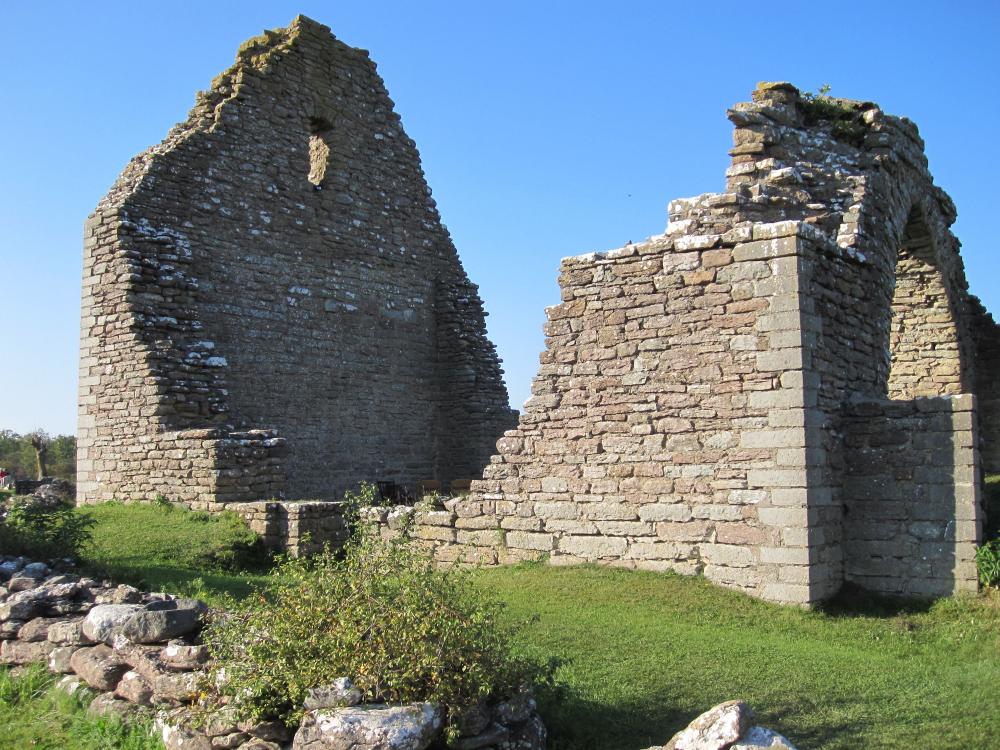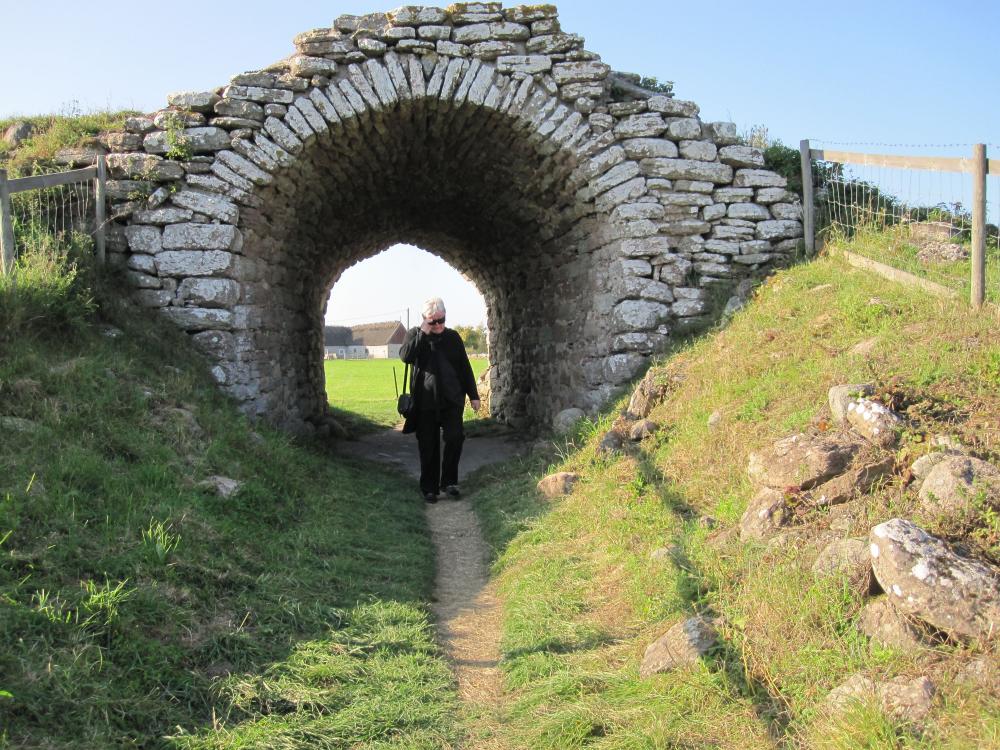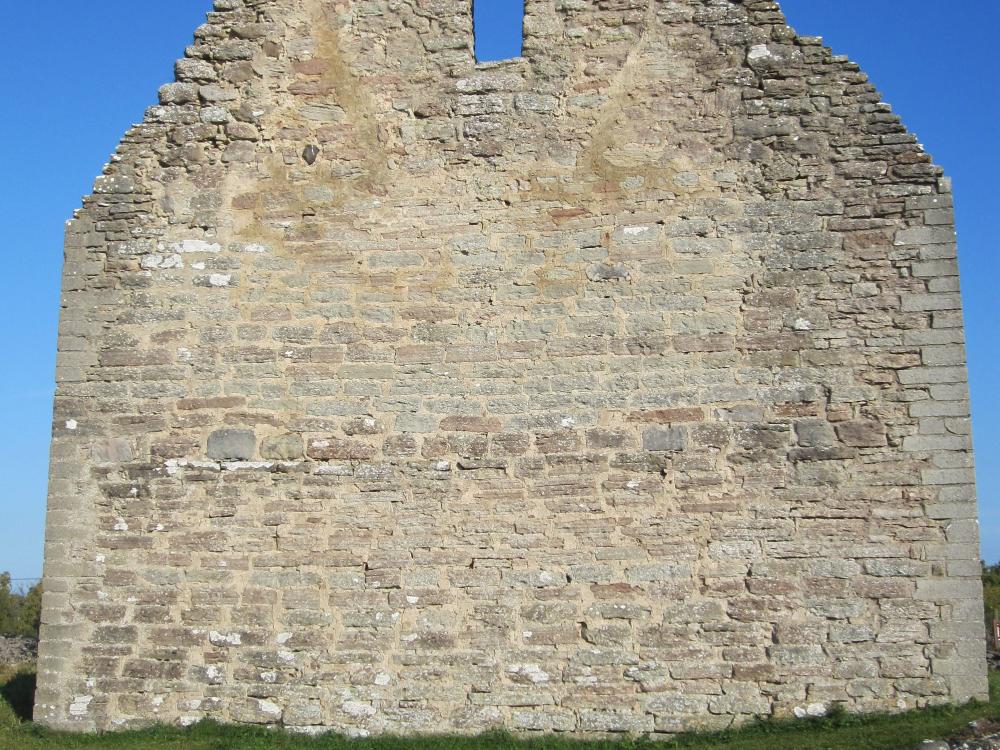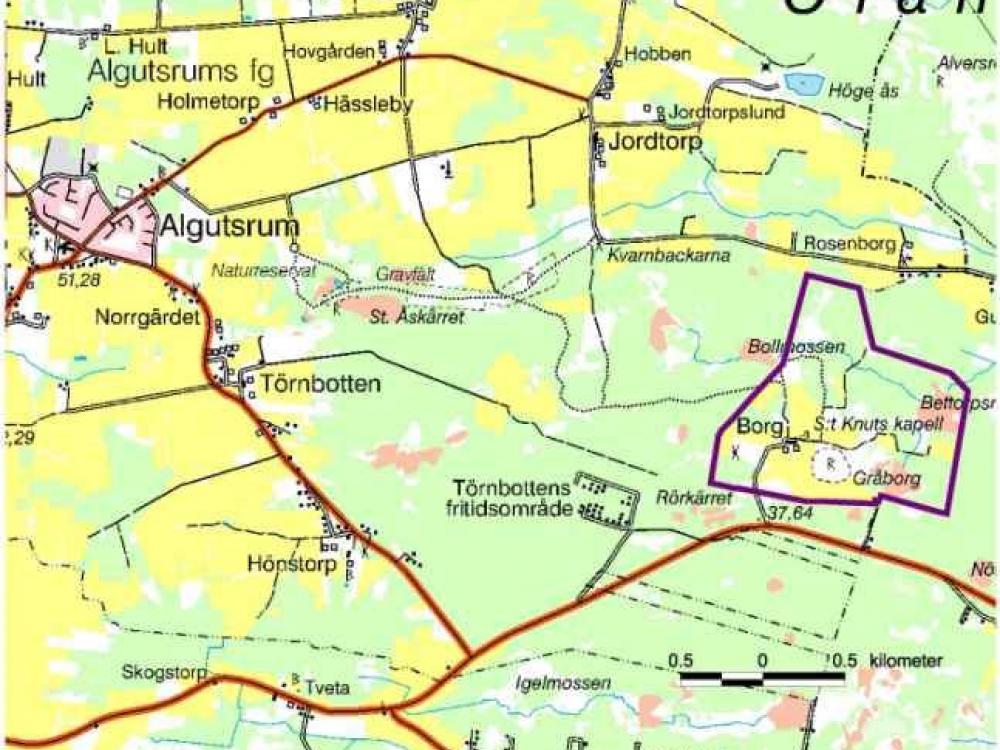Gråborg & S:t Knut’s Chapel
Öland’s biggest ancient castle, built during the Iron Age but was active all the way into historical times. Next to the castle is a medieval chapel ruin and the village Borg with a well maintained cultivation landscape.
Gråborg is Ölands biggest ancient castle and even one of Sweden’s biggest facilities of its kind. Just like Ismantorp, this castle lies right in the middle of the island. The Castle has been named earlier Backaborg but this name has after a while been moved to the closest village Borg.
The castle walls encircles a surface on 210 x 160 meters and the ring walls height varies from 4-7 meters. The walls original height has been up towards 8-10 meters with a thickness of ca 10 meters. Northwest in the castle is a port with a medieval arch and a strong mortar. The castle has had two more ports, one in the north and one in the south corner. According to sources has the existing port had a tower, as well as the southern port.
Historic times
The farmers in the village had under a long time been cultured inside the castle. The Castle walls outside differs a bit from the other ancient castles, most likely because of the vertical insides, which was rebuilt during the medieval times and got the characteristic tapered top of the wall. Outside the northeast and east part of the wall is a weak countersink, probably remains from the moat that once existed. Originally, has the moat been somewhat lower here and that’s why the moat is a logical explanation. Gråborg is often compared to Eketorp’s Castle which also has been used for a long time. It was built during the Iron Age but has played a significant role in historic times. We know it was used during the war against the Danish people 1677. Some archeological surveys with closer affirmations about the castle’s age don’t exist. In the 1920’s was the ports examined and recently has a limited examine been made, which doesn’t encircles the deeper culture layers.
Archeological findings
The castle’s meaning during the medieval times has without a doubt been considerable and confirmed partly by the large amount of small findings, where the medieval material is considering. The castles function has most likely changed from being a stronghold going towards commerce spots and maybe even a kind of administrative center. When the castle, 1450, belonged to Vadstena monastery was taxed in salt, which implies on commerce activities.
Chapelruin
S:t Knut’s Chapel, 200 meters north from the castle, indicates that the castle had a big influence during the medieval times. The Chapel, was originally about 18 x 7 meters, was built during the 1100’s without a tower and was fitted with absidia. The top of the wall was tapered slightly to the east and was fitted with windows with round bars and slanted sockel. The chapel was expanded during Gothic times and was provided with an ogival. The chapel was abandoned already during the 1500’s, and the only bell they had was confiscated by the crown in 1560’s. Today is only the left side and the triumph arch left. One rod cross pour is nowadays in Algutsrum church as well as the altar cabinet which is one of Öland’s biggest one. The Chapel has probably been surrounded by a smaller graveyard; skeletons as well as grave stones have been found close by. The Chapel has been hallowed for the Danish saint Knut who was murdered during a rebellion in Odense year 1086 and was later a patron at the Danish trade organization Knutsgillet.
Safe keeping
Borg’s village is today two farms owned by Vitterhetsakademin. Here they try to keep the old ways of farming by using traditional methods in meadows and fields. The buildings are preserved partly incorporated the barns in shifts under the ceiling. Year 1540 was Borg only one farm which belonged to Vadstena monastery.
The castle walls encircles a surface on 210 x 160 meters and the ring walls height varies from 4-7 meters. The walls original height has been up towards 8-10 meters with a thickness of ca 10 meters. Northwest in the castle is a port with a medieval arch and a strong mortar. The castle has had two more ports, one in the north and one in the south corner. According to sources has the existing port had a tower, as well as the southern port.
Historic times
The farmers in the village had under a long time been cultured inside the castle. The Castle walls outside differs a bit from the other ancient castles, most likely because of the vertical insides, which was rebuilt during the medieval times and got the characteristic tapered top of the wall. Outside the northeast and east part of the wall is a weak countersink, probably remains from the moat that once existed. Originally, has the moat been somewhat lower here and that’s why the moat is a logical explanation. Gråborg is often compared to Eketorp’s Castle which also has been used for a long time. It was built during the Iron Age but has played a significant role in historic times. We know it was used during the war against the Danish people 1677. Some archeological surveys with closer affirmations about the castle’s age don’t exist. In the 1920’s was the ports examined and recently has a limited examine been made, which doesn’t encircles the deeper culture layers.
Archeological findings
The castle’s meaning during the medieval times has without a doubt been considerable and confirmed partly by the large amount of small findings, where the medieval material is considering. The castles function has most likely changed from being a stronghold going towards commerce spots and maybe even a kind of administrative center. When the castle, 1450, belonged to Vadstena monastery was taxed in salt, which implies on commerce activities.
Chapelruin
S:t Knut’s Chapel, 200 meters north from the castle, indicates that the castle had a big influence during the medieval times. The Chapel, was originally about 18 x 7 meters, was built during the 1100’s without a tower and was fitted with absidia. The top of the wall was tapered slightly to the east and was fitted with windows with round bars and slanted sockel. The chapel was expanded during Gothic times and was provided with an ogival. The chapel was abandoned already during the 1500’s, and the only bell they had was confiscated by the crown in 1560’s. Today is only the left side and the triumph arch left. One rod cross pour is nowadays in Algutsrum church as well as the altar cabinet which is one of Öland’s biggest one. The Chapel has probably been surrounded by a smaller graveyard; skeletons as well as grave stones have been found close by. The Chapel has been hallowed for the Danish saint Knut who was murdered during a rebellion in Odense year 1086 and was later a patron at the Danish trade organization Knutsgillet.
Safe keeping
Borg’s village is today two farms owned by Vitterhetsakademin. Here they try to keep the old ways of farming by using traditional methods in meadows and fields. The buildings are preserved partly incorporated the barns in shifts under the ceiling. Year 1540 was Borg only one farm which belonged to Vadstena monastery.



